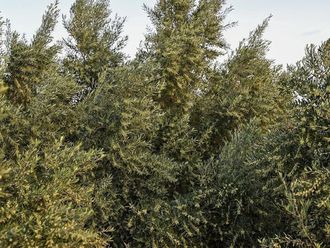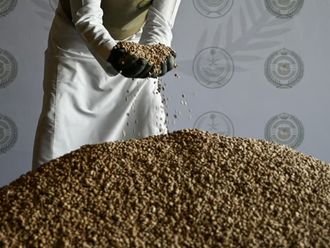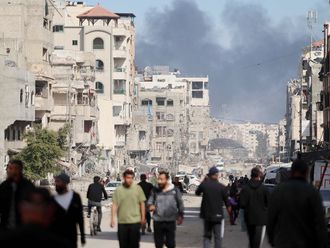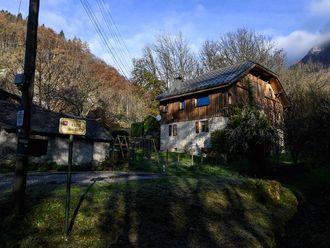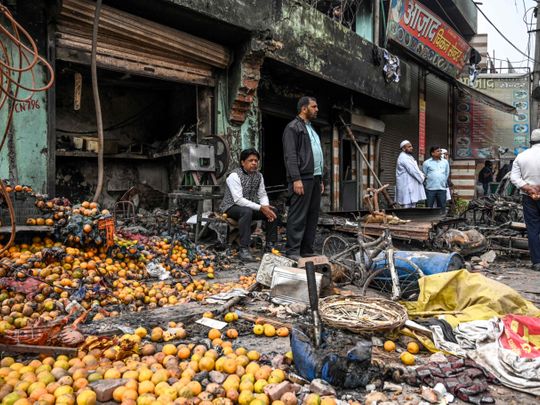
New Delhi: I was just back at my hotel room in Shahdara late on Tuesday afternoon after having attended the joint media briefing by visiting United States President Donald Trump and Indian Prime Minister Narendra Modi and was settling down to send my dispatch when one look out of the huge glass window sent a chill down my spine. Thick, black plumes of smoke was emanating from a clutch of houses far away in the horizon. Within the next five minutes, similar black plumes were seen emerging from three other places in the vicinity. It left me wondering what could be the reason behind that. I grew curious, fished out my mobile and turned the compass on and the worst fears were confirmed as the compass needle confirmed the location as somewhere in northeast Delhi – the riot-hit national capital area that has seen at least 35 deaths since last Monday.
There was an eerie feeling in the air as I was checking into the hotel earlier in the wee hours of the morning. As a thick blanket of smog enveloped Delhi and gave the sodium vapour lamp-lit streets a rather spooky look, the entrance to the five star-rated hotel was all dark. Even the lobby lights were out. Upon enquiring, all that I was told by the person manning the reception desk was: “There was some stone-pelting in the adjoining neighbourhood. So we wanted to avoid attracting attention with those spot lights and garden glows.”
During the following days, as news channels flashed images of a smouldering northeast Delhi and the death count kept mounting, everything fell into a pattern: The smoke on the horizon, the blackout at the hotel lobby, the closed Metro stations in Maujpur-Babarpur, Jaffrabad and the refusal by app cab drivers to accept ride requests from a certain part of the city. “Sorry, I can’t drop you to Shahdara. No one is venturing to that side,” was what a cab driver told Gulf News within a couple of minutes after booking a ride from Connaught Place to Shahdara on Wednesday afternoon. It took quite a bit of convincing to finally get him to budge.
Burnt wood, cloth and metal
On Thursday morning as Gulf News visited the outskirts of Jaffrabad-Babarpur, the air was still thick with the smell of burnt wood, cloth and metal. The dingy, arterial roads mostly bore a deserted look, barring personnel from Delhi Police and Rapid Action Force and their vehicles. And mind you, one was still far from the deepest areas of the neighbourhood that had seen looting, arson and shooting at random since early Monday and well into Tuesday night.
The Metro stations in Maujpur-Babarpur, Jaffrabad are now operating as normal. Shoot-at-sight orders and Section 144 have also been lifted, but the moment you scratch beneath the surface, the air appears heavy with a sense of mutual distrust on either side of the religious divide.
‘Raw aggression’
Earlier on Thursday, just outside Jaffrabad Station on Delhi Metro’s Pink Line, which had seen ugly scenes of altercation between those who supported and those who opposed the recently-introduced Citizenship Amendment Act on Monday, Gulf News caught up with Rehmatullah Seddiqui, a man in his late 50s who runs a tailoring shop in Babarpur. “I’ve stayed here since I was in my teens. I could never even in my wildest nightmare imagine that the mohallah (neighbourhood) that I have known like the back of my palm can turn out to be so ugly in its show of raw aggression,” he told Gulf News. On further quizzing him as to who could have masterminded such a carnage, all he said was: “Some of those who had come armed with iron rods and sticks were outsiders.”
There was severe anguish in the voices of many people who were standing nearby, as they heard Seddiqui speak. One of them, a youth in his mid-20s, Prakash Gulati, told Gulf News: “Had the police reacted with more vigour and purpose on Sunday itself, this [the violence and deaths] could have been prevented to a large extent. In many cases, as the goons came armed to their teeth, the men in uniform stood as mute spectators and were clearly outnumbered.”
Many of the old-timers from the area that Gulf News spoke to said they were too shocked to see what was happening in their neighbourhood.
According to reports in a section of the local media, beat policemen on duty apparently did not have clear instructions from their higher-ups as to what should or could be the extent of a “fitting reply” to miscreants. This void in action plan on the part of the lawkeepers was utilised to the hilt by the vandals who clearly had a plan: Fanning the flames of communal hatred.



